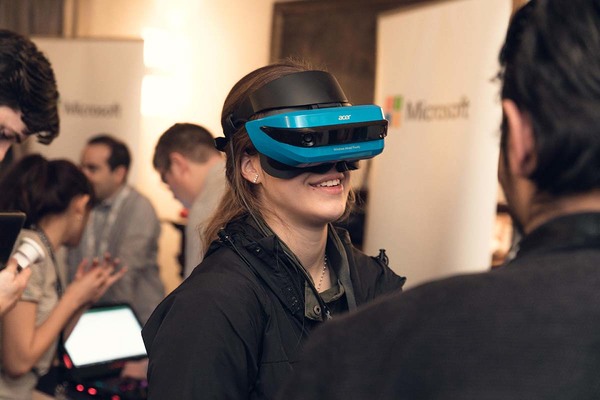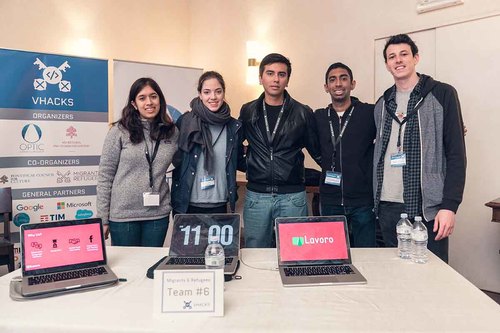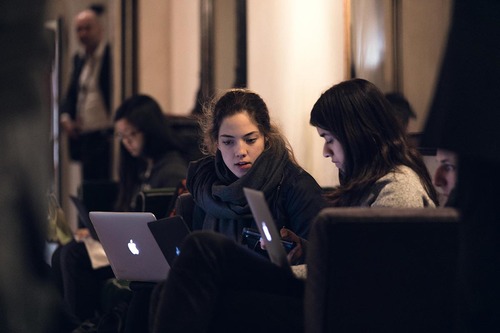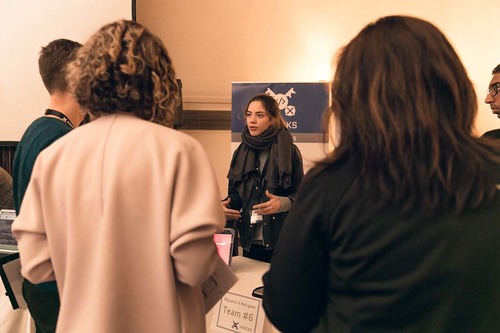
María Inés Aranguren, a senior computer science major, traveled to Rome, Italy on a Nanovic Institute grant to participate in Vatican City's first ever "hackathon." At the four-day competition, 120 students worked in teams to use technological innovation to solve global problems. Working as a software developer for her team, Aranguren helped develop a website that migrants and refugees can use to more easily connect with potential employers.
Traveling to Rome, learning from a diverse group of enthusiastic and intelligent students and speakers, seeing Pope Francis, and gaining insight into how to use technology for social impact was incredibly unforgettable for me. This experience was an excellent complement to my Notre Dame education and my growth from it will carry through to my career post-graduation.
VHacks: Inspired by the Pope
VHacks was the first-ever hackathon held in March 8-11, 2018. The hackathon took place in Vatican City and was inspired by the words of Pope Francis: “How wonderful would it be if the growth of scientific and technological innovation would come along with more equality and social inclusion.” At the hackathon, teams of 4-5 students created projects with the goal of reducing or breaking down social barriers and embracing common values in three thematic areas: (1) social inclusion, (2) interfaith dialogue, and (3) migrants and refugees. After having been selected by VHacks, I proposed to participate in this hackathon as a software developer on one of the small teams.
 Aranguren with her team
Aranguren with her team
There were three main reasons for which I wanted to participate in VHacks. Firstly, I wanted to learn more about the three themes of the hackathon and understand the challenges relating to them, particularly with regards to migrants and refugees.
Secondly, I wanted to participate in VHacks in order to cultivate skills in teamwork and interdisciplinary collaboration. I feel that this is particularly relevant to preparing me for my career path post-graduation.
Last but not least, I was incredibly enthusiastic about VHacks because of the opportunity to gain an understanding of how to use computing to combat global issues. Learning how to use computing to work against social concerns is one of my priorities and is exactly what I hope to do after graduating. I wanted to be part of VHacks in order to learn from mentors and speakers and their experience as well as get to know other students that share my same passion.
I also wanted to go to VHacks and bring some of that enthusiasm back to campus, particularly to a group of students that are part of a club I co-founded and am leading called CS for Good, which seeks to open up conversations about using technology for meaningful purposes and creating opportunities to do hands-on computing work with local community partners.
The True Purpose of Engineering

I truly believe that the core purpose of engineering is to improve others’ quality of life. The extent to which engineers are successful is directly proportional to the degree to which they achieve this. The mission of VHacks is "to use technological innovation to overcome social barriers and embrace common values." Participating in the hackathon reaffirmed my belief that technology is only meaningful if it is helping solve problems people face.
In addition to that, VHacks reminded me that solutions are almost always interdisciplinary. In order to create positive and lasting change, we must not only become experts in our fields of study but also learn and understand what is happening in the world and often work with other people or institutions.
I have a long way to go in understanding the world around me, even at a local level, and continuing to build up my technical skills, but VHacks has reinvigorated my passion to use technology and engineering for the good of others.
Developing a Facebook Chatbox to Help Migrants
At VHacks, I formed part of a team of five students in the migrants and refugees section. After ideating and brainstorming with mentors for a while, we decided to build a tool to help job seekers connect with potential employers based on skills-matching.
 Aranguren presenting her project
Aranguren presenting her project
We implemented a website where job seekers and employers could create their profile. Job seekers would input their skills and basic user information. On the other hand, employers could post job openings with a description and information about the skills the job required. With that information, our tool would analyze job postings and the degree of match with job seekers and then inform both sides when there was a match. For that part of the project, we created an automatic Facebook chatbot because we learned that many migrants and refugees have access to smart devices and often use social media such as Facebook.
Moreover, my team and I thought that using existing technology would reduce the barrier of entry for the job seekers since it would not require them to download another app or become familiar with yet another interface. The messages the chatbot would send were translated into the user’s preferred language and supplemented with images to reduce the language barrier. From there, the employer and candidate would then be connected to handle the rest of the hiring process. Though we were not able to implement this within our time frame, our tool was also meant to implement a two-way rating system to incentivize good performance and trust between employers and employees. This tool was designed to make the job-finding process more passive and less burdensome as a temporary solution for migrants and refugees in transition periods.
Starting from determining the project to implementing the different parts and integrating it together, building this tool was definitely challenging. My favorite part of doing this was detecting the language of the input text and translating it to another language. In order to do this, I used some developer tools made by Google.
I enjoyed presenting my project in the end to judges and telling the story behind it. Though we did not win, I still truly value the opportunity I had to participate and learn from such a unique crowd and experience.

VHacks reminded me that solutions are almost always interdisciplinary. In order to create positive and lasting change, we must not only become experts in our fields of study but also learn and understand what is happening in the world and often work with other people or institutions. I have a long way to go in understanding the world around me, even at a local level, and continuing to build up my technical skills, but VHacks has reinvigorated my passion to use technology and engineering for the good of others.